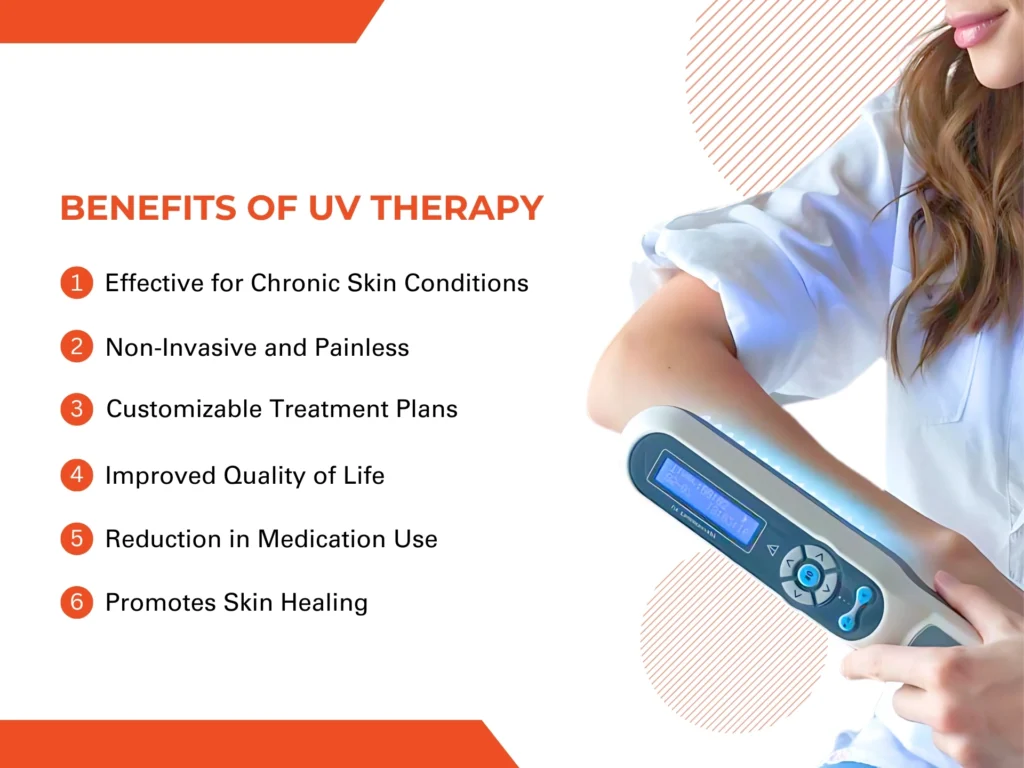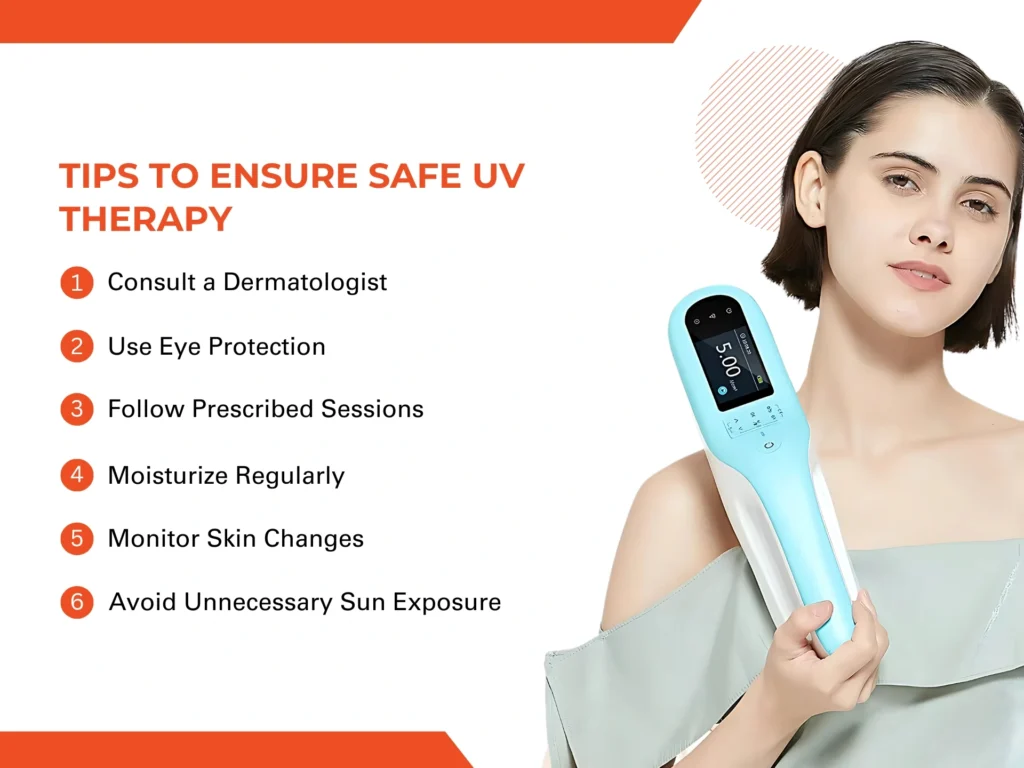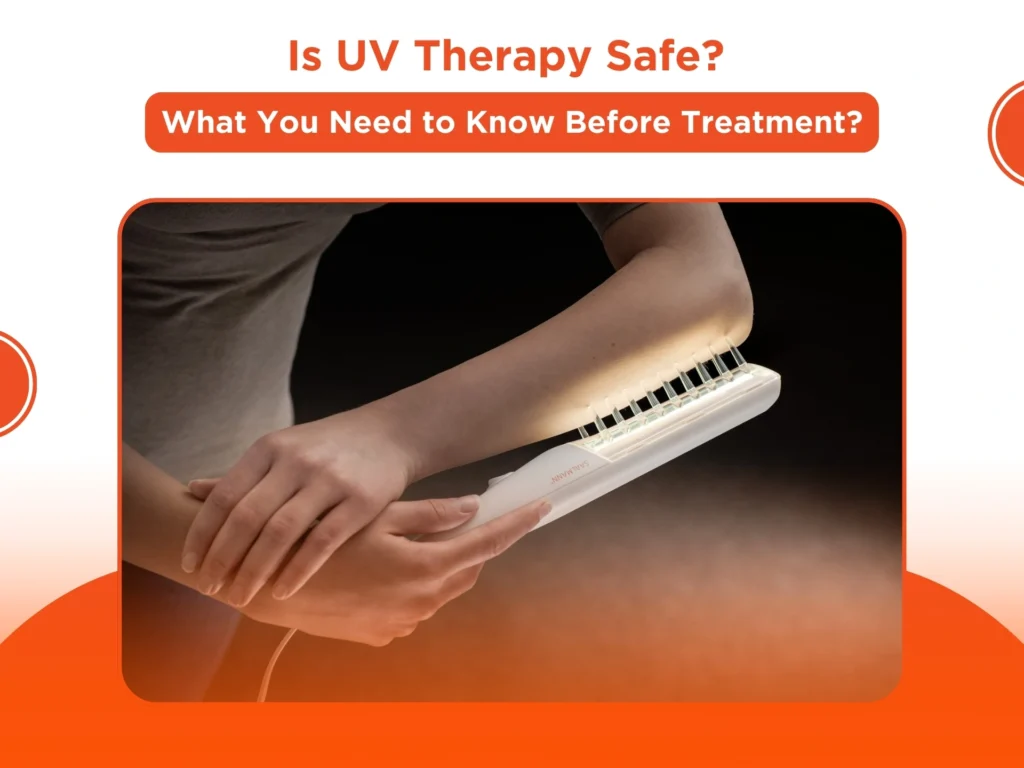UV therapy, also known as phototherapy, is a trusted and widely recognized treatment for managing chronic skin conditions such as eczema, psoriasis, and vitiligo. By exposing the skin to controlled ultraviolet light, UV therapy provides significant relief from persistent symptoms like inflammation, itching, and scaling. However, as with any medical procedure, understanding the safety, benefits, and potential risks of UV therapy is essential. This guide delves into how UV therapy works, its benefits, and what to consider before beginning treatment.
How Does UV Therapy Work?
UV therapy operates by utilizing specific wavelengths of ultraviolet light, primarily UVB and UVA rays, to address problematic areas of the skin. These wavelengths have unique therapeutic properties that make them effective for managing chronic skin conditions.
UVB Therapy
UVB light focuses on the skin’s outermost layers (epidermis), where inflammation and excessive cell production occur. This therapy is particularly beneficial for:
- Psoriasis: Slows the rapid turnover of skin cells that leads to scaling and plaques.
- Eczema: Reduces inflammation and itching by modulating the skin’s immune response.
UVA Therapy
UVA light penetrates deeper into the skin and is often combined with a photosensitizing agent in a procedure known as PUVA therapy (psoralen + UVA). This combination:
- Enhances the skin’s responsiveness to light treatment.
- It is used for more severe or stubborn cases of psoriasis, vitiligo, and certain forms of eczema.
This controlled exposure allows for targeted treatment of affected areas, minimizing risks associated with prolonged or unsupervised UV exposure.
Benefits of UV Therapy

1. Effective for Chronic Skin Conditions
UV therapy offers numerous advantages, making it a preferred choice for both patients and dermatologists. Here’s why it stands out as a safe and effective treatment option:
1. Effective for Chronic Skin Conditions
UV therapy addresses the underlying causes of chronic skin conditions by reducing inflammation, normalizing cell production, and alleviating persistent symptoms such as redness, scaling, and itching. Many patients experience long-term remission after consistent therapy.
2. Non-Invasive and Painless
Unlike surgical or injectable treatments, UV therapy is entirely non-invasive. Patients simply stand or sit in a specialized lightbox or use handheld devices for localized treatment, ensuring a pain-free experience.
3. Customizable Treatment Plans
Each therapy session is tailored to the patient’s specific needs, taking into account factors such as skin type, condition severity, and medical history. This individualized approach enhances the effectiveness and safety of the treatment.
4. Improved Quality of Life
For individuals dealing with debilitating skin conditions, UV therapy provides a path to clearer, healthier skin. Regular treatments not only improve physical symptoms but also boost confidence and emotional well-being by reducing visible signs of the disease.
5. Reduction in Medication Use
Many patients find that UV therapy reduces their reliance on topical steroids, oral medications, or systemic treatments. This minimizes the potential side effects associated with long-term drug use, making UV therapy a safer, more sustainable option for chronic conditions.
6. Promotes Skin Healing
By improving blood flow and oxygenation to the affected areas, UV therapy enhances the skin’s natural healing process, making it an effective adjunct for managing scars and pigmentation issues related to chronic conditions.
Is UV Therapy Safe?
UV therapy, when administered under the supervision of trained healthcare professionals, is generally considered safe and effective for managing chronic skin conditions. The procedure is carefully controlled, with each session tailored to the patient’s specific needs. This ensures the correct dosage of ultraviolet light is applied, minimizing the likelihood of adverse effects. While it is a trusted treatment in dermatology, understanding the potential side effects and long-term risks is crucial for making an informed decision.
Why Does Supervision Matter?
Professional oversight ensures that UV therapy:
- Targets only the affected areas, reducing unnecessary exposure to healthy skin.
- Uses precise wavelengths and durations, tailored to the patient’s condition and skin type.
- Mitigates risks by adhering to safety protocols, such as protective eyewear and skin assessments before and after each session.
Common Side Effects of UV Therapy
While UV therapy is non-invasive and well-tolerated, it may result in some mild and temporary side effects. These can usually be managed with simple adjustments to the treatment plan or additional care routines:
1. Mild Sunburn
- Cause: Overexposure during treatment can lead to redness or slight irritation, mimicking a mild sunburn.
- Management: Applying fragrance-free moisturizers or cool compresses can soothe the skin and prevent further irritation.
2. Dry Skin
- Cause: UV exposure can strip the skin of its natural oils, leading to dryness or flakiness.
- Management: Regular use of emollients or hydrating creams can keep the skin moisturized and comfortable between sessions.
3. Tanning or Pigmentation Changes
- Cause: The treated skin may darken slightly or develop uneven pigmentation, particularly in sensitive areas.
- Management: These changes are typically temporary and fade after discontinuing therapy. Consistent use of sunscreen can also help prevent additional pigmentation.
Long-Term Risks
Although UV therapy is effective for many patients, extended or unsupervised use may carry long-term risks. Awareness of these potential complications allows patients and providers to take preventative measures.
1. Skin Aging
- Risk: Prolonged UV exposure can accelerate the development of wrinkles, fine lines, and sunspots, mimicking the effects of natural aging.
- Prevention: Dermatologists may recommend alternating UV therapy with other treatments or using protective creams to minimize photodamage.
2. Skin Cancer Risk
- Risk: While the risk is low when UV therapy is properly managed, extended exposure over many years may increase the likelihood of non-melanoma skin cancers, such as basal cell carcinoma or squamous cell carcinoma.
- Prevention: Routine skin checks and limiting the duration of UV therapy can significantly mitigate this risk. Treatment plans are designed with this consideration in mind to minimize cumulative UV exposure.
3. Eye Damage
- Risk: Without adequate eye protection, UV rays can cause irritation, dryness, or, in severe cases, long-term damage like cataracts.
- Prevention: Protective goggles are mandatory during every session to shield the eyes from harmful UV rays. Patients are encouraged to report any discomfort to their healthcare provider immediately.
Balancing Effectiveness and Safety
When supervised appropriately, UV therapy strikes an effective balance between therapeutic benefits and manageable risks. Patients considering UV therapy should discuss their medical history, skin condition, and potential concerns with their dermatologist to determine if this treatment is the right fit for them. By adhering to professional guidance and incorporating skin care best practices, the risks associated with UV therapy can be minimized while maximizing its benefits.
Who Should Avoid UV Therapy?
While UV therapy is a highly effective treatment for many chronic skin conditions, it may not be suitable for everyone. Certain medical histories, conditions, or circumstances may make this therapy less advisable. Patients should always consult a healthcare provider to determine if UV therapy is a safe option for their individual needs. Here are some situations where caution or alternative treatments might be necessary:
1. History of Skin Cancer
- Reason: UV exposure, even in controlled settings, may increase the likelihood of recurrence or new skin cancer development.
- Advice: Patients with a history of melanoma or other skin cancers should discuss their risks thoroughly with a dermatologist before proceeding.
2. Photosensitivity
- Reason: Conditions like lupus or medications such as antibiotics, diuretics, or certain antidepressants can heighten UV sensitivity, causing severe burns or adverse reactions.
- Advice: Those with known photosensitivity should avoid UV therapy or consider lower-dose alternatives under strict medical supervision.
3. Pregnancy
- Reason: While no definitive risks to the fetus have been established, some healthcare providers err on the side of caution and recommend avoiding UV therapy during pregnancy.
- Advice: Pregnant individuals should explore alternative treatments for managing skin conditions during this time.
4. Active Infections or Open Wounds
- Reason: UV light may exacerbate irritation or delay the healing of open wounds or infections.
- Advice: Wait until the infection has cleared or the wounds have healed before starting UV therapy.
Tips to Ensure Safe UV Therapy

UV therapy can deliver excellent results when conducted safely and responsibly. Following these tips can help maximize its benefits while minimizing potential risks:
1. Consult a Dermatologist
- Why: A dermatologist can assess your condition, review your medical history, and determine whether UV therapy is appropriate for you. They’ll also develop a customized treatment plan to optimize results.
- Tip: Bring a list of current medications and any past skin issues to your consultation for a thorough evaluation.
2. Use Eye Protection
- Why: UV light can damage the eyes, leading to irritation, cataracts, or long-term complications.
- Tip: Always wear the goggles provided during therapy sessions and ensure they fit properly for complete coverage.
3. Follow Prescribed Sessions
- Why: Overexposure to UV light can lead to burns, pigmentation changes, or an increased risk of skin cancer.
- Tip: Stick to the prescribed frequency and session duration. Never attempt to self-administer or prolong sessions to expedite results.
4. Moisturize Regularly
- Why: UV therapy can dry out the skin, making it prone to flaking or irritation.
- Tip: Use dermatologist-recommended moisturizers before and after therapy to keep your skin hydrated and comfortable.
5. Monitor Skin Changes
- Why: Early detection of unusual symptoms can prevent complications or the worsening of side effects.
- Tip: Report any unexpected changes, such as blistering, severe redness, or dark spots, to your healthcare provider immediately.
6. Avoid Unnecessary Sun Exposure
- Why: UV therapy already exposes your skin to ultraviolet light, and additional exposure can increase risks.
- Tip: Wear sunscreen, protective clothing, and avoid direct sunlight during peak hours to protect your skin.
Read More: Orthopedic Health and Wellness: Medicare‘s Contribution to a Pain-Free Life
How Does Heal Medical Supply Ensure Safe UV Therapy?
At Heal Medical Supply, we understand that safety and effectiveness are paramount when it comes to UV therapy. Our mission is to provide high-quality equipment and personalized support to help you achieve optimal results while minimizing risks. Here’s how we make UV therapy a safe and seamless experience for our clients.
Why Choose Us?
1. State-of-the-Art Devices
- Advanced Technology: Our UV therapy devices are designed with precision to deliver controlled doses of ultraviolet light, ensuring effective treatment while minimizing potential side effects.
- Customizable Settings: Adjustable features cater to individual treatment plans, whether targeting specific areas or covering broader skin concerns.
2. Expert Guidance
- Professional Support: Our team of specialists is available to guide you through every step of the process, from selecting the right device to understanding how to use it safely.
- Tailored Advice: We work closely with your healthcare provider to ensure your therapy aligns with your specific medical needs and goals.
3. Educational Resources
- Comprehensive Information: We provide detailed instructions on the safe and effective use of UV therapy devices, covering topics like session frequency, device maintenance, and protective measures.
- FAQs and Tips: Our resources also address common concerns, empowering you with knowledge to maximize therapy benefits.
4. Ongoing Support
- Continuous Assistance: Whether you have questions about your device, need help adjusting settings, or require troubleshooting, our customer support team is here to help.
- Proactive Monitoring: We encourage regular check-ins to assess your progress and address any issues, ensuring a smooth and effective therapy experience.
Conclusion
UV therapy is a proven, effective treatment for chronic skin conditions when administered under professional supervision. By targeting the root causes of conditions like psoriasis, eczema, and vitiligo, UV therapy offers significant relief, improves overall quality of life, and reduces dependency on medications. Whether used as a standalone treatment or part of a comprehensive care plan, UV therapy continues to be a safe and reliable option in modern dermatology.
If you’re considering UV therapy, consult with a dermatologist to ensure it’s the right choice for your condition and health needs. With proper guidance, UV therapy can be a transformative step toward healthier, more comfortable skin.




